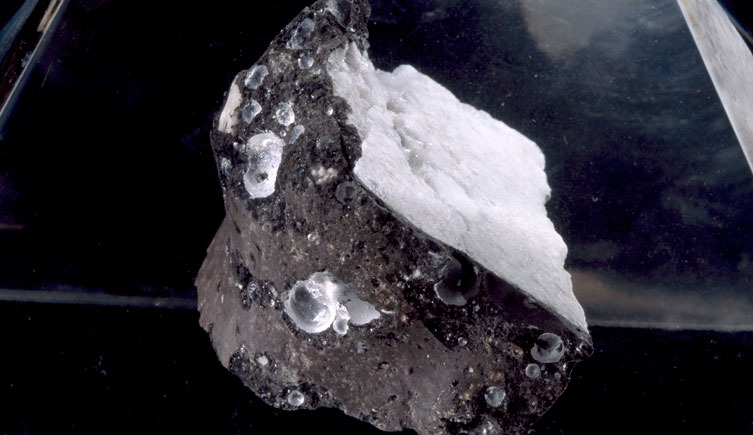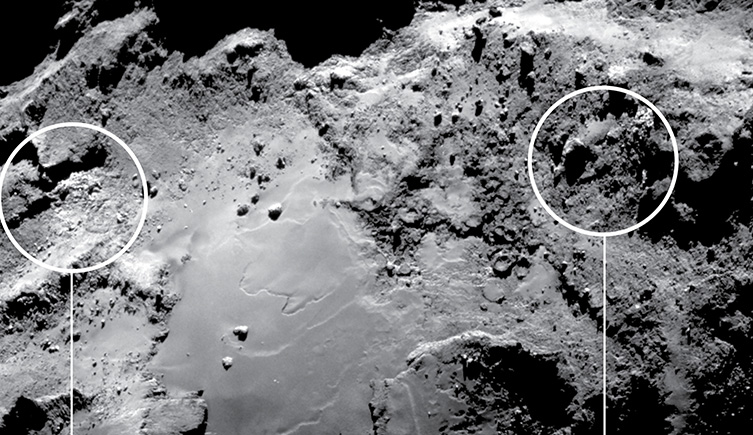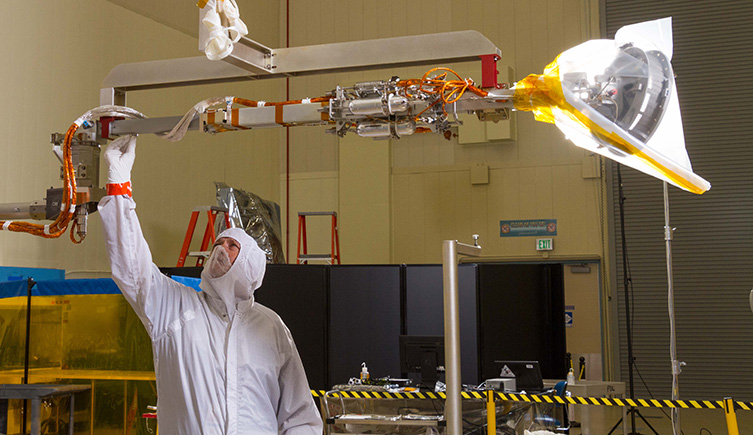
Water ice was discovered on the surface of Comet 67P/Churyumov–Gerasimenko by the European Space Agency's (ESA) Rosetta craft. Image courtesy of ESA.
Deep in the Museum basement, there is an air of reverence among assembled scientists as the Ivuna meteorite - a rock older than planet Earth - is lifted from its sealed case.
Beneath Ivuna's modest grey exterior, water lies trapped inside its minerals, hiding clues about the beginnings of the solar system and the source of water on planet Earth.
With access to a world-class collection of rare meteorites like Ivuna and samples from the Apollo missions, a group of planetary geologists from the Museum is exploring new analytical techniques to narrow down where our water came from and what happened to it along the way.
Meanwhile, these scientists have an eye on several tiny crafts currently hurtling through space - ambitious sample-return missions that offer an unprecedented opportunity to study pristine hydrous material from bodies in our solar system.
Immaculate meteorites
Ivuna belongs to an elite group of carbonaceous meteorites called the CI chondrites. Out of approximately 50,000 meteorites known to science, just nine of them are CI chondrites.
'There aren't many of them but they're incredibly interesting,' says Museum geologist Dr Ashley King. 'CI chondrites formed early in solar system history, 4.6 billion year ago, but they still contain up to 20 weight-percent extraterrestrial water - they're the most water-rich meteorites we have.'
When the planets were first forming, they experienced a near-constant barrage of meteorite impacts. Among these were meteorites like Ivuna, which may have brought water - and potentially other building blocks of life - to Earth billions of years ago.
The blue planet
Unlike the free-flowing water covering Earth's surface, the water inside CI chondrites is trapped inside the structure of phyllosilicate minerals, also known as clays.
Different phyllosilicates form under different pressures, temperatures and time periods, so Dr King can use the mineral assemblages of meteorites like Ivuna to work out the conditions the rock - and water - have experienced through time.
Meteorites that have experienced hydrous alteration - like Ivuna - probably had ice on their parent body at some point, which then melted and altered the rock's original minerals.
'People have suggested that CI chondrites may have come from comets, because comets have such a high weight-percentage of water,' says Dr King. 'Nobody's found anything yet that definitely comes from a comet, but if we do it will probably be something like Ivuna.'
It's feasible that enough of these hydrous meteorites battered the early Earth to produce the profoundly blue planet we live on today. And if carbonaceous chondrites like the CIs are one of the main sources of water on Earth, they were probably also the source of water on the Moon.

The Ivuna meteorite fell to Earth in Tanzania in 1938. A rare CI chondrite, it contains up to 20 weight-percent of extraterrestrial water.
Moon misunderstandings
Prof Sara Russell is the Head of the Mineral and Planetary Sciences Division at the Museum, and has a long-standing interest in water on the Moon.
'When I was growing up and a graduate student I was told that the Moon is completely bone dry, no water at all. That was the conclusion from the Apollo mission. Now I'm working on projects to calculate the volume of lunar water and determine where it came from…so we've come a long way.'
Prof Russell is involved with a project led by Dr Jessica Barnes of the Open University, who is studying lunar meteorites and rocks collected during the Apollo missions. Barnes found water in lunar rocks that were up to 4.5 billion years old, proving that water existed on our satellite very early in its history.
To determine the source of the lunar water, Barnes measured the ratio of the elements deuterium and hydrogen (D/H). This ratio acts as a fingerprint for the water's source, which - in this case - looked very familiar.
'We found that the lunar water has a very similar composition to water found in Earth rocks and in some carbonaceous chondrites,' says Dr Barnes, 'which suggests that Earth and the Moon likely received their water from similar sources - most likely primitive asteroids.'
Dr Barnes is now modelling scenarios of different impactors - comets, asteroids, or something else entirely - that could account for the D/H values of water on Earth and the Moon.
The exact combination of remote water sources will be difficult to determine, but our ability to identify the parent bodies of meteorites and the water on them may soon be given a significant boost.
The data is out there
Several hundred million miles from Earth, the European Space Agency's Rosetta craft is currently orbiting a comet, periodically beaming back data collected by its vast array of scientific equipment.
Prof Russell says:
' The analytical instruments on Rosetta are comparable to ours - the measurements it takes are really similar to the analyses we do on meteorites in the laboratory.'
Remote sensing missions like Rosetta act as incredibly valuable 'proofs' for the work Dr King, Prof Russell and Dr Barnes are doing. They allow us to compare samples or data collected in space with meteorites from Earth's surface to see whether we're on the right track in matching meteorites with their sources.
Unsurprisingly, however, there are limitations in remotely observing large, dark rocks hurtling through space at thousands of miles an hour.
'It's really hard,' says Dr King, 'these asteroids and comets are really small, they're really dark, and the data you get back are very difficult to interpret. Measurements of meteorites in the lab and measurements in space are really difficult to tie together.'
Sample-return missions
-

NASA's Apollo missions were the first to sample extraterrestrial material in situ and return it to Earth. This anorthosite breccia was collected during the Apollo 16 mission in April 1972 and is now held in the Museum's collections.
-

ESA's Rosetta craft successfully deployed a lander on the surface of a comet in 2014, and is now orbiting and surveying the comet. These two exposures of water ice were photographed by Rosetta in 2014. Image courtesy of ESA.
-

NASA's OSIRIS-REx spacecraft, due to launch September 2016, will sample material from the surface of an asteroid. Image courtesy of NASA.
-

The OSIRIS-REx craft will collect rocks using its sampling arm and return them to Earth in 2023. Image courtesy of NASA.
Space souvenirs
The ideal scenario for planetary geology, says Prof Russell, is to study a pristine sample taken directly from an asteroid or comet.
'A sample return is optimum, because then you have the geological context. With meteorites you don't have that luxury, you've got no idea where it came from, and you probably don't know for sure whether it's from an asteroid or a comet.'
Comparing meteorites to samples collected in-situ from asteroids and comets allows scientists to determine - to some extent - which bodies are the 'parents' of different kinds of meteorite.
Luckily for us, Prof Russell is part of an imminent NASA sample-return mission, OSIRIS-REx, which will land on a dark, primitive asteroid, sample material, and - crucially - bring it back home to Earth in 2023. OSIRIS-REx will be hot on the tail of the Japan Aerospace Exploration Agency's Hayabusa 2, another sample-return mission already winging its way through space towards a similar asteroid. The Japanese mission will orbit the asteroid, map it, and bring back samples in 2022/3.
A previous Japanese sample-return mission, Hayabusa, visited an S-type asteroid in 2005. The pristine material it collected was compared with meteorites that we believed came from 'S-type' parent bodies, and the two were an excellent match. Researchers like Dr King are now hoping for a similar happy ending after Hayabusa 2 and OSIRIS-REx visit asteroids we believe may be the source of CI and other carbonaceous meteorites.
For now, Ivuna is placed reverently back into its sealed box among the Apollo samples, the elite CI chondrites, and thousands of other meteorites in the Museum collection. There it will remain until scientists welcome the next batch of samples from the far reaches of the solar system, which they hope may finally expose the otherworldly sources of Earth's water.
Museum team
- Dr Ashley King
- Prof Sara Russell
Collaborators
- Dr Jessica Barnes
The Open University
Publications
- King AJ, Schofield PF, Howard KT and Russell SS (2015). Modal mineralogy of CI and CI-like chondrites by X-ray diffraction. Geochimica et Cosmochimica Acta, 165 : 148-60.
- King AJ, Solomon JR, Schofield PF and Russell SS (2015). Characterising the CI and CI-like carbonaceous chondrites using thermogravimetric analysis and infrared spectroscopy. Earth, Planets and Space, 67 : 198.
- Barnes JJ, Tartèse R, Anand M, McCubbin FM, Franchi IA, Starkey NA and Russell SS (2014). The origin of water in the primitive Moon as revealed by the lunar highlands samples. Earth and Planetary Science Letters, 390 : 244–252.

The meteorite group blog
Follow the blog to hear the latest from our planetary geologists.
Extraterrestrial analysis
X-ray diffraction (XRD)
Analysing how X-rays are deflected by a meteorite sample can help us to identify the minerals present and their abundances.
Scanning Electron Microscopy (SEM)
Beams of charged particles (electrons) enable high-resolution imaging and chemical analysis of meteorites and their components.
Computed tomography (CT)
Firing X-rays through a meteorite allows us to study the internal structure without having to destroy the sample.
Diamond Light Source - synchrotron
X-rays 10 billion times brighter than the Sun allow us to investigate the chemistry of meteorites at a scale 1,000 times smaller than the width of a human hair.
NanoSIMS
Negative secondary ions are collected from areas of a sample that are around 10 times smaller than the width of a human hair, allowing us to determine where in the solar system volatiles came from.
Related projects

Comets
We are learning about the formation and evolution of comets using material collected by NASA's Stardust spacecraft.

Asteroids
We are studying chondrite meteorites to understand conditions in the early solar system and the processes that formed the planets.

The Moon
Lunar meteorites and Apollo samples are helping our scientists to better understand the origins and evolution of the Moon.